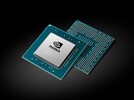Intel HD Graphics P630 vs NVIDIA Quadro T1000 Max-Q
Intel HD Graphics P630
► remove from comparison
The Intel HD Graphics P630 (GT2) is an integrated graphics unit, which can be found in various Xeon workstation processors of the Kaby Lake generation. The "GT2" version of the Skylake GPU offers 24 Execution Units (EUs) clocked at up to 1050 MHz (depending on the CPU model). Due to its lack of dedicated graphics memory or eDRAM cache, the P630 has to access the main memory (2x 64bit DDR3L-1600 / DDR4-2133). It uses the same silicon as the consumer HD Graphics 630 in Kaby-Lake-H processors but features optimized drivers for workstaion and CAD software. According to Intel it is certified for 15 applications (see list).
Performance
According to Intel, the performance of the P630 is identical to the Intel HD Graphis P530 (Skylake predecessor) processor graphics card and 1.94x faster than the old Intel HD Graphics P4000. Compared to consumer cards, the gaming performance should be on a similar level to the dedicated GeForce 920M and will handle old games (as of 2015) in low or medium settings.
Features
The revised video engine in the Kaby Lake chips now supports H.265/HEVC Main10 profile at 10-bit color depth and also the VP9 codec in hardware. Furthermore, HDCP 2.2 is also supported in all chips, which allows Netflix 4K videos, for instance.
Power Consumption
The HD Graphics P630 can be found in mobile quad-core Xeon processors with 45 W TDP and also desktop processors of the Xeon range with higher TDPs.
Source: http://www.intel.com/content/dam/www/public/us/en/documents/guides/hd-graphics-performance-guide.pdf
NVIDIA Quadro T1000 Max-Q
► remove from comparison
The Nvidia Quadro T1000 with Max-Q Design is a professional mobile graphics card that is based on the Turing architecture (TU117 chip). Compared to the consumer GTX 1650, the Quadro T1000 features less CUDA cores / shaders (768 versus 896). The chip is manufactured in 12nm FinFET at TSMC. Compared to the normal Quadro T1000, the Max-Q variants are clocked lower and work in a more efficient state. Currently, we know of two variants with different clock speeds and power consumptions (35 and 40 W).
| Model | Shader | TGP (W) | Base (MHz) | Boost (MHz) |
| Quadro T1000 Mobile | 768 | 50 | 1395 | 1455 |
| Quadro T1000 Max-Q | 768 | 40 | 1230 | 1455 |
| Quadro T1000 Max-Q | 768 | 35 | 795 | 1455 |
| Quadro T2000 Mobile | 1024 | 60 | 1575 | 1785 |
| GeForce GTX 1650 Mobile | 896 | 50 | 1395 | 1560 |
The Quadro T1000 is a mobile graphics card that is based on the Turing architecture (TU116 chip). Compared to the faster RTX 2000 GPUs (e.g. RTX 2060), the T1000 integrates no Raytracing or Tensor cores. Due to the same boost clock as the mobile T1000, the Max-Q variants can perform similar with sufficient cooling.
The Turing generation did not only introduce raytracing for the RTX cards, but also optimized the architecture of the cores and caches. According to Nvidia the CUDA cores offer now a concurrent execution of floating point and integer operations for increased performance in compute-heavy workloads of modern games. Furthermore, the caches were reworked (new unified memory architecture with twice the cache compared to Pascal). This leads to up to 50% more instructions per clock and a 40% more power efficient usage compared to Pascal.
Thanks to the low power consumption, the Max-Q T2000 GPU can be used in thin and light laptops. The used TU116 chip is manufactured in 12nm FFN at TSMC.
| Intel HD Graphics P630 | NVIDIA Quadro T1000 Max-Q | |||||||||||||||||||||||||||||||||||||||||||||||||||||||||||||||||||||||||||||||||||||||||||
| Quadro Turing Series |
|
| ||||||||||||||||||||||||||||||||||||||||||||||||||||||||||||||||||||||||||||||||||||||||||
| Codename | Kaby-Lake-H-GT2 | N19P-Q1 | ||||||||||||||||||||||||||||||||||||||||||||||||||||||||||||||||||||||||||||||||||||||||||
| Architecture | Gen. 9.5 Kaby Lake | Turing | ||||||||||||||||||||||||||||||||||||||||||||||||||||||||||||||||||||||||||||||||||||||||||
| Pipelines | 24 - unified | 768 - unified | ||||||||||||||||||||||||||||||||||||||||||||||||||||||||||||||||||||||||||||||||||||||||||
| Memory Bus Width | 64/128 Bit | 128 Bit | ||||||||||||||||||||||||||||||||||||||||||||||||||||||||||||||||||||||||||||||||||||||||||
| Shared Memory | yes | no | ||||||||||||||||||||||||||||||||||||||||||||||||||||||||||||||||||||||||||||||||||||||||||
| API | DirectX 12_1, OpenGL 4.4 | DirectX 12_1, OpenGL 4.6 | ||||||||||||||||||||||||||||||||||||||||||||||||||||||||||||||||||||||||||||||||||||||||||
| technology | 14 nm | 12 nm | ||||||||||||||||||||||||||||||||||||||||||||||||||||||||||||||||||||||||||||||||||||||||||
| Features | QuickSync | |||||||||||||||||||||||||||||||||||||||||||||||||||||||||||||||||||||||||||||||||||||||||||
| Date of Announcement | 05.08.2015 | 27.05.2019 | ||||||||||||||||||||||||||||||||||||||||||||||||||||||||||||||||||||||||||||||||||||||||||
| Core Speed | 795 / 1230 - 1455 (Boost) MHz | |||||||||||||||||||||||||||||||||||||||||||||||||||||||||||||||||||||||||||||||||||||||||||
| Memory Speed | 8000 MHz | |||||||||||||||||||||||||||||||||||||||||||||||||||||||||||||||||||||||||||||||||||||||||||
| Memory Type | GDDR5 | |||||||||||||||||||||||||||||||||||||||||||||||||||||||||||||||||||||||||||||||||||||||||||
| Max. Amount of Memory | 4 GB | |||||||||||||||||||||||||||||||||||||||||||||||||||||||||||||||||||||||||||||||||||||||||||
| Power Consumption | 35 - 40 Watt | |||||||||||||||||||||||||||||||||||||||||||||||||||||||||||||||||||||||||||||||||||||||||||
| Notebook Size | medium sized |
| |||||||||||||||||
Benchmarks
Average Benchmarks Intel HD Graphics P630 → 0% n=0
* Smaller numbers mean a higher performance
1 This benchmark is not used for the average calculation
For more games that might be playable and a list of all games and graphics cards visit our Gaming List











